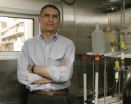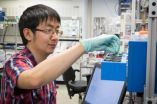(Press-News.org) Bacteria are particularly ingenious when it comes to survival strategies. They often create a biofilm to protect themselves from a hostile environment, for example during treatment with antibiotics. A biofilm is a bacterial community that is surrounded by a protective slime capsule consisting of sugar chains and "curli". Scientists at VIB and Vrije Universiteit Brussel have for the first time created a detailed three-dimensional image of the pores through which the curli building blocks cross the bacterial cell wall, a crucial step in the formation of the protective slime capsule. In addition to the fundamental insights provided by this work, the new results could in the long-term also result in many useful applications.
Han Remaut (VIB/VUB): "By determining the three-dimensional structure, it is now possible to develop small molecules that fit like a stopper in the pore of the transporter. This inhibits the excretion of the curli building blocks and can prevent the formation of curli fibers and unwanted biofilms during infections or in industrial installations."
Bacteria have other ingenious protection systems
Bacteria protect themselves against external stress factors by organizing as a biofilm. This allows pathogenic bacteria to defend themselves against treatment with antibiotics, or allows them to hide from the immune system. Bacteria also create biofilms in industrial installations, which can hamper the processes in the installation and result in blockages. Biofilms are bacterial communities that surround themselves with a protective slime capsule consisting of sugar chains and protein fibers or "curli". In order to produce this protective slime capsule, bacteria use a modified transport system to deliver curli building blocks safely to the outside of the bacteria, so that the curli fibers can be produced there.
Transport system is crucial link in defense process
Parveen Goyal and Han Remaut (VIB/VUB) reported in Nature this week on a breakthrough in the unravelling of this curli transport system. Using X-ray crystallography, they succeeded for the first time in making a detailed three-dimensional image of the pore along which the curli building blocks are transported through the bacterial cell wall. Transporting these building blocks to the outside is a remarkable feat for the bacteria. It requires energy and as curli-forming bacteria have a double cell wall, they do not have access to the usual cellular motors that drive these transport channels. Parveen Goyal (VIB/VUB): "Based on the structure of the secretion channel, we are able for the first time to build a model of how bacteria can cross this barrier."
Using biofilms for new applications?
Biofilms of non-pathogenic bacteria can also exhibit desirable properties that we can use for new applications. Han Remaut (VIB/VUB): "As they are able to polymerize by themselves and are extremely stable, curli fibers have great potential as building blocks for functional nano wires." Curli fibers could be used as carriers for other proteins, thereby forming so-called functional biofilms. For example, by coating the curli fibers with proteins and enzymes that absorb, convert or break down specific substances, they can be used for waste water treatment or the conversion of biofuels. This requires further research, but the research group reported the first steps in this direction earlier this year.
INFORMATION:
Publication
Research was published in the leading journal Nature.
Nature, September, 2014.
New insights in survival strategies of bacteria
2014-09-15
ELSE PRESS RELEASES FROM THIS DATE:
How an ancient vertebrate uses familiar tools to build a strange-looking head
2014-09-15
Kansas City, Mo. - If you never understood what "ontogeny recapitulates phylogeny" meant in high school, don't worry: biologists no longer think that an animal's "ontogeny", that is, its embryonic development, replays its entire evolutionary history. Instead, the new way to figure out how animals evolved is to compare regulatory networks that control gene expression patterns, particularly embryonic ones, across species. An elegant study published in the September 14, 2014 advance online issue of Nature from the Stowers Institute for Medical Research shows just how humbling ...
Breast screening for over 70s doesn't prompt sharp fall in advanced disease
2014-09-15
Instead, it may just lead to overdiagnosis and overtreatment, suggest the researchers, led by a team based at Leiden University Medical Centre in the Netherlands.
Their paper publishes as the Preventing Overdiagnosis conference opens next week (Monday 15 Sept), where experts from around the world will discuss how to tackle the threat to health and the waste of money caused by unnecessary care. The conference is hosted by the Centre for Evidence-Based Medicine at the University of Oxford in partnership with The BMJ's Too Much Medicine campaign.
The upper age limit for ...
Experts raise concern over unnecessary treatment of mild hypertension in low risk people
2014-09-15
Dr Stephen Martin and colleagues argue that this strategy is failing patients and wasting healthcare resources. They call for a re-examination of the threshold and urge clinicians to be cautious about treating low risk patients with blood pressure lowering drugs.
Their paper publishes as the Preventing Overdiagnosis conference opens next week (Monday 15 Sept), where experts from around the world will discuss how to tackle the threat to health and the waste of money caused by unnecessary care. The conference is hosted by the Centre for Evidence-Based Medicine at the University ...
Genetic testing can identify men at 6-fold increased risk of prostate cancer
2014-09-15
Scientists can now explain a third of the inherited risk of prostate cancer, after a major international study identified 23 new genetic variants associated with increased risk of the disease.
The study brings the total number of common genetic variants linked to prostate cancer to 100, and testing for them can identify 1% of men with a risk of the disease almost six times as high as the population average.
Scientists at The Institute of Cancer Research, London, and in Cambridge, UK, and California led a huge search for new genetic variants including almost 90,000 men ...
Rules of thumb for climate change turned upside down
2014-09-15
Based on models and observations, climate scientists have devised a simplified formula to describe one of the consequences of climate change: regions already marked by droughts will continue to dry out in the future climate. Regions that already have a moist climate will experience additional rainfall. In short: dry gets drier; wet gets wetter (DDWW).
However, this formula is less universally valid than previously assumed. This was demonstrated by a team of ETH climate researchers led by Peter Greve, lead author of a study recently published in Nature Geoscience. Traditional ...
Measuring modified protein structures
2014-09-15
Cells regulate protein functions in a wide variety of ways, including by modifying the protein structure. In an instant, a protein can take on another form and perform no or even the "wrong" function: in humans, proteins that fold wrongly can cause serious diseases such as Alzheimer's, Parkinson's or cystic fibrosis. Some of these proteins also have a tendency to "infect" other molecules of the same type and congregate into insoluble so-called amyloid fibrils or plaques. These amyloids can damage cells and tissues and make people ill.
Method breaks the shackles
Until ...
UNC researchers find final pieces to the circadian clock puzzle
2014-09-15
CHAPEL HILL, NC – Researchers at the UNC School of Medicine have discovered how two genes – Period and Cryptochrome – keep the circadian clocks in all human cells in time and in proper rhythm with the 24-hour day, as well as the seasons. The finding, published today in the journal Genes and Development, has implications for the development of drugs for various diseases such as cancers and diabetes, as well as conditions such as metabolic syndrome, insomnia, seasonal affective disorder, obesity, and even jetlag.
"Discovering how these circadian clock genes interact has ...
Cheaper alternative to licensed drug for treating eye disease has similar side-effects
2014-09-15
Health policies which favour using ranibizumab for treating eye disease in older people over safety concerns for a cheaper alternative should take account of a new Cochrane Review published today. The researchers looked at the results of studies which compared the safety of two drugs used for treating age-related macular degeneration, ranibizumab and bevacizumab. Contrary to what was argued by some experts the review has found that the cheaper drug, bevacizumab, does not appear to increase deaths or serious side-effects compared with ranibizumab in people with neovascular ...
Study sheds new light on why batteries go bad
2014-09-15
Menlo Park, Calif. — A comprehensive look at how tiny particles in a lithium ion battery electrode behave shows that rapid-charging the battery and using it to do high-power, rapidly draining work may not be as damaging as researchers had thought – and that the benefits of slow draining and charging may have been overestimated.
The results challenge the prevailing view that "supercharging" batteries is always harder on battery electrodes than charging at slower rates, according to researchers from Stanford University and the Stanford Institute for Materials & Energy Sciences ...
Marijuana users who feel low get high
2014-09-15
PISCATAWAY, NJ – Adolescents and young adults who smoke marijuana frequently may attempt to manage negative moods by using the drug, according to a study in September's Journal of Studies on Alcohol and Drugs.
"Young people who use marijuana frequently experience an increase in negative affect in the 24 hours leading up to a use event, which lends strong support to an affect-regulation model in this population," says the study's lead author Lydia A. Shrier, M.D., M.P.H., of the division of adolescent and young adult medicine at Boston Children's Hospital.
She notes ...


